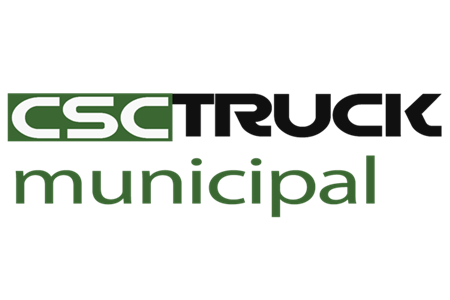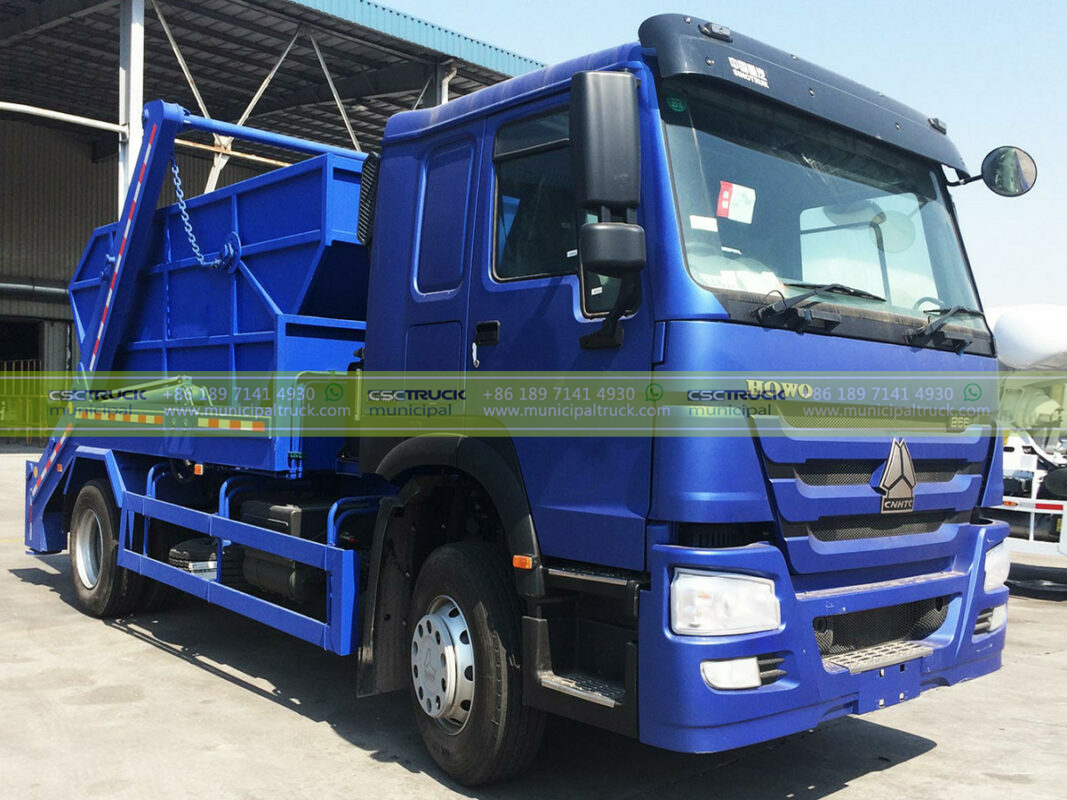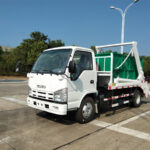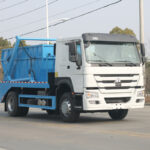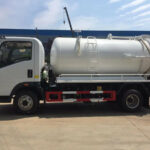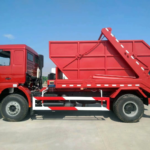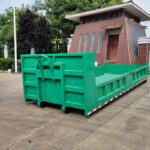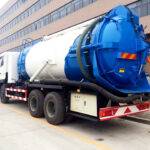Industrial operations generate waste on a scale that dwarfs typical household refuse. Mountains of packaging, manufacturing byproducts, construction debris, and discarded materials pose a significant logistical and environmental challenge. Traditional waste collection methods falter under this sheer volume and weight. Enter the skip loader garbage truck – a robust, versatile, and often underappreciated champion specifically engineered to tackle the demanding world of industrial waste management. This sophisticated piece of equipment is not merely a truck; it’s a mobile waste handling system, pivotal in keeping factories, construction sites, and large facilities clean, compliant, and efficient.
The Industrial Waste Quandary – Volume, Hazard, and Complexity
Industrial waste streams are fundamentally different from municipal solid waste. They are characterized by:
- Sheer Volume and Density: Factories, warehouses, and construction sites produce waste in massive quantities, often bulky and heavy (metal scraps, pallets, building materials, production off-cuts). Standard rear-loaders or even many front-loaders struggle with the scale and weight, leading to inefficiency and potential damage.
- Diverse Material Composition: Waste can range from inert cardboard and plastic to potentially hazardous materials, heavy metals, liquids (requiring containment), or sharp objects. This diversity demands robust handling and often specialized containment solutions.
- Irregular Generation and Location: Waste generation isn’t always predictable or centralized. Production spikes, project phases, or site-specific operations mean waste accumulates in different areas, sometimes in hard-to-reach spots within a large facility or across sprawling construction sites.
- Regulatory Stringency: Industrial waste disposal is heavily regulated. Improper handling, mixing of incompatible wastes, or spillage can lead to significant fines and environmental damage. Secure containment and reliable transportation are non-negotiable.
- Operational Downtime Costs: Time spent managing waste is time not spent on core production or construction activities. Slow, inefficient collection disrupts workflows and impacts the bottom line.
Traditional bin systems or manual loading simply cannot cope with these multifaceted challenges efficiently or safely. A more powerful, adaptable solution is essential.
The Skip Loader Solution – Engineering for Heavy-Duty Performance
The skip loader garbage truck is purpose-built to address the specific pain points of industrial waste. Its core design philosophy revolves around strength, versatility, and efficiency:
- Robust Chassis and Powertrain: Built on heavy-duty commercial truck chassis, often with powerful diesel engines and reinforced drivetrains, these vehicles are engineered to handle constant heavy lifting and demanding terrain common on industrial sites or construction zones.
- Hydraulic Muscle: High-capacity hydraulic systems provide the immense power required to lift, transport, and empty loaded skips weighing several tons with ease and control.
- The Versatile Skip: The heart of the system. Industrial skips (also called dumpsters or containers) come in various sizes (typically 10 to 40 cubic yards) and configurations. Crucially, they are designed to be extremely durable, often featuring reinforced steel construction, spill lips, and optional features like locking lids, leak-proof sumps for liquids, or specialized liners for hazardous materials. This allows waste to be securely contained at the point of generation.
- Efficient Collection Model: The skip-based system allows for staged waste accumulation. Skips are placed strategically where waste is generated. Once full, the skip loader garbage truck arrives, collects the entire skip, and replaces it with an empty one – a rapid exchange minimizing disruption.
Subsection: The Hook Lift Mechanism – The Engine of Versatility
Central to the skip loader garbage truck’s unmatched flexibility is its hook loader system. This ingenious mechanism, mounted on the truck’s frame, consists of powerful hydraulic arms terminating in robust hooks. Here’s how it transforms operations:
- Effortless Engagement: The driver maneuvers the truck close to the skip. Using controls (often from within the cab), the hydraulic arms extend, and the hooks engage precisely with lifting points (pins or bars) on the skip frame.
- Precise Lifting and Loading: Once securely hooked, the powerful hydraulics lift the entire skip smoothly off the ground. The arms then articulate, pivoting the skip over the truck’s chassis and lowering it securely onto the truck bed. This entire process typically takes only a matter of minutes.
- Secure Transport: The skip is locked firmly onto the truck bed for safe transportation to the disposal or recycling facility.
- Swift Unloading and Exchange: At the disposal site, the process reverses. The hook loader lifts the loaded skip off the truck, deposits it for emptying, and then typically picks up an empty skip (if required) and loads it back onto the truck for the return journey. This seamless exchange is the cornerstone of operational efficiency.
This hook loader garbage truck capability means one truck can service an incredible variety of skip sizes and types without modification, adapting instantly to the waste needs of different clients or even different areas within the same large facility.
Operational Advantages – Efficiency, Safety, and Cost Savings
Deploying skip loader garbage trucks translates into tangible, significant benefits for industrial waste generators:
- Dramatically Reduced Collection Time: The rapid skip exchange process, often completed in under 5 minutes per container, means a single truck can service numerous locations in a single run. This drastically cuts fuel costs, labor hours, and vehicle wear-and-tear compared to manual loading systems.
- Enhanced Site Safety: Minimizing manual handling of heavy or hazardous waste is paramount. The mechanized lifting eliminates the risks associated with workers lifting heavy items into a truck or compacting mechanism. Secure containment within robust skips also prevents spillage, leaks, and windblown debris on-site.
- Maximized Site Productivity: The quick exchange minimizes disruption to core operations. Forklifts or other equipment aren’t tied up loading waste trucks, and noisy collection activities are brief. Waste is contained neatly in skips until removal.
- Unmatched Flexibility and Scalability: Need a small skip for office waste and a large one for scrap metal? The hook loader garbage truck handles both effortlessly. As project phases change or waste volumes fluctuate, the skip sizes and collection frequency can be easily adjusted. This adaptability is invaluable for dynamic industrial environments.
- Improved Waste Segregation and Compliance: Using multiple, clearly labeled skips for different waste streams (e.g., general waste, recyclables, hazardous materials) becomes practical and efficient with the skip system. This promotes recycling, simplifies disposal logistics, and ensures compliance with strict waste handling regulations by keeping streams separate and contained.
- Reduced Infrastructure Damage: Concentrated weight from heavy, wheeled bins can damage concrete floors or asphalt over time. Skips distribute weight more evenly while stationary and are lifted, not dragged, eliminating this damage.
Environmental Stewardship and Sustainable Impact
Beyond operational efficiency, the skip loader garbage truck plays a crucial role in promoting environmentally responsible industrial waste management:
- Enabling Effective Recycling: The ease of using dedicated skips for recyclables (cardboard, metal, plastics) directly increases capture rates. Cleaner, segregated streams are more valuable and easier to process at Material Recovery Facilities (MRFs). The skip loader efficiently collects these full containers, ensuring recyclables actually reach the recycling stream.
- Safe Hazardous Waste Handling: Specialized skips with sealed lids and containment sumps, efficiently serviced by the skip loader, are essential for managing oils, solvents, contaminated materials, or other hazardous industrial byproducts, preventing soil and water contamination.
- Optimized Transportation: By consolidating large volumes of waste into single, dense skip loads, fewer truck trips are required compared to systems collecting smaller, less dense loads. This directly reduces fuel consumption, traffic congestion, and associated greenhouse gas emissions per ton of waste transported.
- Waste Reduction Awareness: The visibility of large skips filling up provides a tangible indicator of waste generation, often prompting businesses to investigate source reduction strategies or more efficient material usage to minimize disposal costs and environmental footprint.
- Landfill Diversion: Efficient collection and segregation facilitated by the skip system are fundamental prerequisites for diverting significant volumes of industrial waste away from landfills and towards recycling, composting, or waste-to-energy facilities.
Beyond the Bin – The Enduring Relevance of the Skip Loader
In an era increasingly focused on automation and novel technologies, the fundamental design and function of the skip loader garbage truck remain remarkably relevant and effective. Its strength lies in its powerful simplicity and unparalleled adaptability. While innovations like onboard weighing, route optimization software, and telematics enhance its operation, the core hook loader mechanism and skip-based approach continue to be the most practical solution for heavy, voluminous, and diverse industrial waste streams.
It’s a testament to robust engineering that this platform can handle everything from pristine cardboard bales to demolition rubble, from scrap metal to regulated hazardous containers, all with the same basic chassis and hydraulic system. The skip loader garbage truck is not a stopgap; it’s the optimized tool for a specific, critical job. Its ability to minimize operational disruption, enhance safety, ensure regulatory compliance, and contribute to sustainability goals makes it an indispensable asset for industries of all kinds. As industrial activity grows and waste management pressures intensify, the role of this powerful, versatile workhorse becomes ever more crucial in maintaining clean, efficient, and responsible operations. The quiet efficiency of the hook loader arm lifting a laden skip is a daily symbol of industrial waste being managed effectively, reliably, and out of sight – a silent guarantee that the wheels of industry can keep turning without being buried under their own refuse. It is the dependable, powerful backbone of industrial sanitation, a true unsung hero in the complex landscape of modern waste management.
